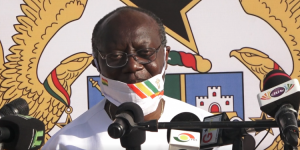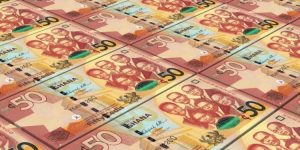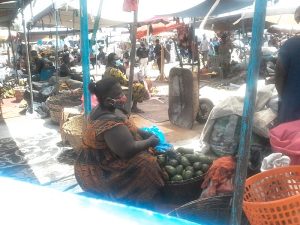The biggest question in the minds of all stakeholders in Ghana’s economy was answered last week as Government Statistician, Samuel Kobina Annim announced the latest economic growth data from the Ghana Statistical Service. Ghana’s economic growth slowed marginally in the first quarter of 2021 as the recovery from last year’s slump struggles to gain momentum.
Gross domestic product expanded 3.1% from a year earlier, marginally slower than the 3.3% growth rate achieved in the three months through to December 2020. The economy grew 0.8% from the previous quarter.
The first quarter growth rate is less than half the 7.0 percent growth recorded during the first quarter of 2020 but this was only to be expected; COVID 19 arrived in Ghana in March last year meaning the first quarter of last year was the last reporting period for the pre-COVID 19 economy.
Following the rise in growth, the value of the economy has increased to GH¢45.4 billion in the first quarter of 2021 from GH¢43.9 billion in the same period in 2020
The latest growth data has generated a mixed reaction from economists and financial analysts. While some expressed disappointment that first quarter 2021 growth was slower than fourth quarter 2020 growth, pointing to the fragility of Ghana’s rebound out of the economic recession that gripped the economy in the second and third quarters of last year, others noted that the relatively stronger growth during the last quarter of 2020 was in fact largely the result of the contracted base used in the computations after two successive quarters of economic contraction and therefore, in absolute terms the first quarter 2021 growth is better than that of the previous quarter.
The 3.1 per cent gross domestic product (GDP) growth rate was driven largely by the non-oil sector and is now the second highest since the COVID-19 pandemic struck in the country in March last year, forcing a near collapse in economic activities and a subsequent drag on growth.
However, it is the lowest first quarter growth since 2016 when the economy contracted by 0.4 percent on the back of the effects of the power outages at the time.
“From a non-oil perspective, we see that on a year on year basis in quarter 1 2021 the economy grew by 4.6 % and also this is a marked dip from the same period between quarter 1 2019 and quarter 1 2020, Annim has asserted. “Where the economy grew by 7.9 percent so again from an oil and a non-oil perspective, the economy has slowed down with its growth rate on a quarter 1 basis for the period January to March 2019 compared with January to March 2020 relative to 2020 quarter 1 and quarter 1 20201”.
Nevertheless, there is general agreement that while the 5 percent growth rate target set by government now looks within reach – after initially being widely termed as over-ambitious when first announced in the 2021 budget proposals – there is a lot that needs to be done to meet it.
Dr Said Boakye, an economist who is the head of research at the Institute for Fiscal Policy, reflects the general opinion of his professional colleagues when he says that the 3.1 percent growth rate for the first quarter falls short of what is needed given that government is aiming to expand the economy by five percent this year.
“If the target is to grow the economy by five per cent this year and the first quarter is below that then there is a problem. It means that over the rest of the quarters, the economy will have to catch up” he points out,
He blames the lower than needed growth rate on the sluggish performance in the oil sector where technical challenges and the slow pace of recovery in the price of oil were causing industry operators to slow down production.
Dr Boakye however believes the strong growth in the non-oil sector is positive for the economy. He says it indicates that firms are returning to normalcy and this could help bring back jobs to ease the burden that COVID 19 has imposed on households.
He says that the first quarter GDP growth figures should serve as a wakeup call for the government to make targeted policy interventions to help lift growth to meet the five percent growth target for 2021.
This will require encouragement for oil companies to step up production to boost oil sector growth and make up for revenue shortfalls.
“The oil sector is suffering and it is suffering because of technical issues and the choices of the producers. These are multinational s with options of where to invest and so when there are challenges, they decide where to invest their money.”
But he also asserts that at an average price of US$71 per barrel, there is no excuse for petroleum companies to be bearish with production numbers.
However, the oil sector is being constrained by the inability to get newly discovered oilfields up and running. After several delays in government’s approval of the Afina field discovered in 2018, Aker Energy now says it needs new equity partners to finance its planned phased development of the field. Meanwhile government’s directive, given in 2020 that ENI and Springfield unitize their respective Sankofa and Pecan fields has resulted in an impasse as ENI is reluctant to comply, arguing that it has not been given sufficient data to make the huge investment decision required. This means no progress has been made towards exploiting the Pecan discovery since it was made
Ghana’s economy is recovering from last year’s pandemic-related movement restrictions and a drop in oil prices that caused its first recession since at least 2007. While Ghana fared better than most of its peers, it created a major blip after growth had recovered to over six percent per annum since 2017, after falling to below four percent during the previous two years. Government expects growth to return to about six percent per annum over the medium term as the impacts of COVID 19 recede and its ambitious GHc100 billion Ghana COVID 19 Alleviation and Recovery of Enterprises Support initiative is implemented, underpinned by GHc70 billion in anticipated private sector investment over the next two years.
The 3.1 per cent gross domestic product (GDP) growth rate was driven largely by the non-oil sector and is now the second highest since the COVID-19 pandemic struck in the country in March last year, forcing a near collapse in economic activities and a subsequent drag on growth.
Manufacturing, which expanded 1.3% after contracting in the three months through December, was one of the main drivers of growth. The agricultural sector slowed to 4.3%, compared with an 8.2% expansion in the previous quarter. Oil and gas contracted 16.2%, while the hospitality sector shrank 10.7%.
The expansion of the economy in the first quarter was driven largely by substantial growth in the construction, manufacturing, crops and information and communications technology sub-sectors. Conversely, the mining and quarrying, hotel and restaurants, forestry and logging, fishing and professional. Administrative and support service sub-sectors, however suffered contractions in growth
As Africa’s biggest gold producer, Ghana’s economy could benefit from the surge in the metal’s price over the last three months. The International Monetary Fund projects GDP growth of 4.6% this year and 6.1% in 2022. An unexpected interest-rate cut by the central bank last month could further bolster the recovery and help offset the impact of new taxes and plans to narrow the budget deficit by restricting public spending.
Economic growth is projected to accelerate in 2021 from last year’s coronavirus-induced slowdown as external and domestic demand gain traction; however, the reading is partly flattered by a favorable base effect. Volatile commodity prices and lingering uncertainty over the Covid-19 pandemic present key downside risks to the current growth projections which vary widely, with the government of Ghana presenting the most optimistic projection of 5.0 percent. Focus Economics panelists project the economy to expand 4.8 percent in 2021, and 5.3 percent in 2022.
Ghana’s economy contracted by 3.2 and 1.1. percent in the second and third quarters of 2020, respectively, pushing the country into a recession for the first time in 38 years.
However, a modest growth of 1.1% was recorded for the full year of 2020 thanks to a strong 4.9% growth in the first quarter of 2020, at the onset of the COVID-19 crisis. The 1.1% GDP growth in 2020 is a steep fall from the pre-COVID-19 levels of 6.5%.
The Government attempted to mitigate the pandemic’s impact on households and businesses by enacting the Coronavirus Alleviation Plan (CAP) and the medium-term COVID-19 Alleviation and Revitalization of Enterprises Support (CARES) program in mid-2020. But the low growth in 2020, coupled with high population growth, has pushed real per capita incomes 1% lower than in 2019.
Ghana’s economy showed early signs of recovery in the second half of 2020 as business sentiments improved with the ending of lockdowns as the year-on-year performance in the agriculture, manufacturing and tradable services sectors saw some strong recoveries in the third quarter of 2020.
Government financing needs increased substantially during the pandemic, pushing the Government to resort to central bank financing, resulting in sharp increases in debt and debt service cost. Fiscal pressures arose from costly financial sector reforms in 2018-2020 and the Energy Sector Recovery Program (ESRP), started in 2019. The overall fiscal deficit, including energy and financial sector costs, was therefore already elevated at 7.6% of GDP in 2019 and the debt-to-GDP ratio at 63.9%.
In 2020, the COVID-19 crisis led to the suspension of the fiscal rule as the fiscal deficit (including financial and energy sector costs) reached 16.2% of GDP and public debt 76.1% of GDP. While debt remains sustainable, the April 2020 Debt Sustainability Analysis (DSA) concluded that Ghana remains at high risk of debt distress. Ghana’s current account deficit widened to 3% of GDP at the end of 2020 from 2.9% in 2019, reflecting a lower trade surplus and higher services out-flows. However, stronger remittance in-flows and lower net investment income outflows, especially from the extractive sector, helped moderate the impact on reserves.
Ghana’s growth outlook continues to improve however, when compared with projections a year ago when COVID 19 was still gripping the economy in a bear hug. The medium-term negative impact of the pandemic on growth will continue to be felt through low external demand, and tourism receipts but Ghana is proving earlier projections wrong in certain areas of economic activity.
Most notably, foreign direct investment rose in 2020 from its admittedly low level in the previous year, reaching US$2.6 billion last year, which is a 139 percent increase over 2019’s FDI intake.
Focus Economics is one of the several research institutions that has consequently revised its growth projections upwards. “Initial, baseline assumptions of low commodity prices, particularly of oil, led to growth projections of 1.4 % in 2021 and further to 3.6% by 2023 (average of 2.2% for 2021-2023). However, recent rapid recoveries of oil prices complimented by the expected implementation of the Ghana CARES Program will likely result in the realization of the upside scenario with 2021 projected growth of 4.2% and a medium term (2021-2023) average growth of 4.5%.” it says.
With relative stability in the exchange rate and the central bank’s gradual return to a tighter monetary policy stance, inflation is expected to moderate to the central bank’s target range. The fiscal and current ac-count balances are expected to improve only slowly over the medium term, largely reflecting adverse external factors and a slow return to normalcy in domestic revenue mobilization.
Instructively the International Monetary Fund, whose views are crucial in influencing the attitude of the international investment community towards Ghana, has also become more upbeat about the country’s economic prospects.
An International Monetary Fund (IMF) mission led by Carlo Sdralevich held consultations under the Article IV during April 28 – May 12, 2021 through virtual meetings. At the conclusion of the mission, Mr. Sdralevich issued a statement which, in part, said that:
“Ghana has managed very effectively the COVID-19 outbreak in the country, and thus succeeded in protecting lives. Almost 93,000 cases have been confirmed, and unfortunately 780 people have died as of today. The launch of mass vaccine rollout has been a breakthrough, with the administration of approximately a million doses as of end-May.
“The impact of the pandemic on the economy has been severe. Real GDP growth slowed to 0.4 percent in 2020 from 6.5 percent in 2019, due to lower activity in the extractive industries and a collapse in hospitality and retail services, including the informal sector that especially employs female workers. Inflation spiked to double digit because of food price pressures, before falling to 8.5 percent in April 2021.
“Policy interventions in 2020 were also critical to safeguard livelihoods and paved the way for a faster rebound of economic activity. Real GDP growth is projected at 4.8 percent in 2021, driven by a rebound in mining and services. Inflation is expected to remain around the central bank’s target of 8 percent by end-2021. The CARES program has the potential to be transformative and inclusive for the Ghanaian economy, buttressed by its emphasis on SMEs and digitalization as well as leveraging the AfCFTA.
“The 2021 budget’s recent policy pivot towards fiscal consolidation is an important step in the right direction and a difficult one in a pandemic. Fiscal consolidation should be deepened and anchored around debt and debt service reduction to create space for social, health, and development spending.
“Given the social and equity implications, fiscal consolidation should rely more on progressive revenue and spending measures, while guaranteeing fiscal support to the most vulnerable and social safety nets.”
All this indicates that Ghana’s economic recovery will be complicated, with government constrained by severe fiscal challenges in its efforts to boost economic activity through increased public spending.
The Bank of Ghana is trying to make up for this by easing monetary policy further, making credit cheaper for the private sector to utilize. Its unexpected 100 basis points cut in its benchmark Monetary Policy Rate in late May has facilitated a reduction in the Ghana Reference Rate (which effectively serves as the base lending rates for all 23 universal banks in the country) by 39 basis points and this is expected to result in a commensurate fall in actual bank lending rates.
Actually, lending rates have been falling since the central bank began sharp monetary easing in March last year but the banks themselves have been retreating from lending to customers, to the relative safety of investments in government debt securities which have been issued in increasing quantities to finance its elevated fiscal deficits.
Thus, while the banks are well positioned to finance the private sector in its efforts to return to customary levels of economic activity, they have not yet garnered the willingness to do so, particularly with the industry’s non- performing loans ratio still at a high of about 15 percent.
Increased lending to the private sector will be crucial to efforts to increase Ghana’s economic growth rate for the rest of this year.
In the meantime, though, the 3.1 percent growth rate recorded for the first quarter of 2021, although lower than what is needed to reach government’s full year target, at least indicates that an economic rebound is indeed underway. The only problem is that it is slower than anticipated – and needed.







